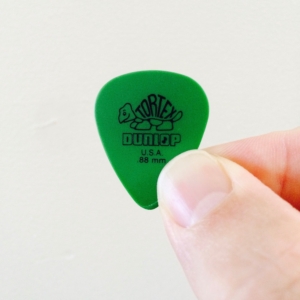Welcome to Part Two of Your First Guitar Song, a four-part series made especially for beginner guitarists.
Last week in Part One we learned the three easy guitar chords (G, A, and D major) needed to play ‘Twist and Shout’ by The Beatles. Now that we’ve learned the finger positions for these chords, let’s learn how to strum a guitar.
How to Strum a Guitar
‘What exactly is a “strum”?’, you ask? Strumming is what the hand that’s not making the chords does in order to make each chord ring out. It involves dragging a guitar pick across some or all six strings of the guitar in order to make the strings produce sound. (If you’re right-handed, this is done with your right hand.)
‘Strumming … [makes] each chord ring out.’
Some players don’t use guitar picks at all – they use finger picks or they just pick with their bare fingers. It’s nice to know that there are other options, but for this series we’ll just use a regular pick since it’s the most common method (and because it’s how The Beatles did it).
There are different ‘gauges’ or thicknesses of picks, but just about any will work – whatever is most comfortable to hold.
Rhythm
The most important aspect of learning how to strum a guitar is rhythm. Each song has its own tempo, or beat, which means that each strum has to be in time with it. The easiest way to make sure you’re in time is to use a metronome. Here’s a good online one that’s free. (There are also many free metronome apps for both Android and iOS.)
‘To [stay] in time … use a metronome.’
Metronomes keep time in beats per minute (bpm), but we’re not going to worry about counting the number of beats or minutes. For now, we just need it for its steady ‘click’ beat. It will help you keep in time as you play through the pattern.
Strumming Patterns
For the most part, each strum will coincide with a ‘click’ of the metronome (though not always). Some strums will be up strokes; some strums will be down strokes. This combined order of up and down strums is called a strumming pattern.
Ready to show off those three easy chords you’ve just learned? Slide the metronome up to 126 bpm and follow the strumming pattern below.
Directions:
- Each arrow coincides with a click of the metronome
- The arrows alternate down and up; your strumming hand should mirror this pattern
- Notice that some clicks (the blue arrows) are skipped; don’t strum on these clicks
- Choose one chord to play for the entire pattern, either G, A, or D. (Don’t worry about chord changes – we’ll get to that next week in Part Three: Changing Chords.)
- Try the whole pattern again with a different chord. Repeat.
NOTE: You might find that the most difficult part of this strumming pattern is on the beat when it switches from down strokes to up strokes. That’s because this beat is syncopated. Syncopated beats can be awkward at first, but in time will get easier. It’s important to get used to them as they are common in many kinds of rhythms.
(For more help on how to get a smooth up and down strumming motion, read our guide to alternate guitar strumming.)
A Few Helpful Tips
- If you tuned in for Part One last week, you will have noticed that both the A and D chord diagrams indicate certain strings are not played in those chords. It’s tricky, but do your best to not hit these omitted strings while strumming those chords. If it helps, use the thumb of your chord hand to mute any bottom (thicker) strings not being played.
- For any blue arrows (i.e. the skipped strums) you should still move your hand up or down so that your hand is in the right place for the next strum (see the video above). Repeating this up/down motion will also help you stay in rhythm.
- Slow it down. If 126 bpm is too fast, lower it as much as you need. Just remember that, whatever the bpm, each arrow in the strumming pattern coincides with a click of the metronome.
Well done! You’ve already learned three easy guitar chords and now you’ve learned how to strum a guitar too. Keep practicing the strumming pattern with a metronome and you’ll be playing ‘Twist and Shout’ in no time!
Having trouble transitioning between chords? Help is on the way! Read Part Three: Changing Chords for more tips on playing and links to other articles in this series.

Cody is a professional singer, songwriter, performer, and recording artist. His instruments include bass, trumpet, drums, harmonica, piano, and most especially guitar. In his spare time he travels, brands businesses, and makes lists of his many accomplishments.
Cody is a student at the University of Utah under his own self-created degree, Music Business and Technology, and recently returned from four months living in Kathmandu, Nepal providing humanitarian aid to the victims of the recent earthquake.
Watch the music video for ‘Batti Ayo’, Cody’s tribute to the Nepal quake victims, at codyrobinsonmusic.com
Or follow him on Instagram: @codyculture







